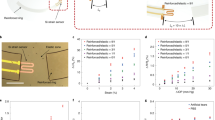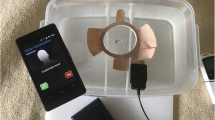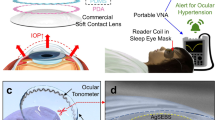Summary
Background
Variations in the shape of the profile of a 24-h continuous, indirect measurement of intraocular pressure with a contact lens sensor may possibly be influenced by artifacts. We examined the sensitivity of a contact lens sensor to changes in temperature that patients may experience during the measurement period.
Material and methods
Three Triggerfish contact lens sensors (Sensimed, Lausanne, Switzerland) were placed in a container with 0.9 % physiological saline solution. The temperature of the solution was either raised with a thermostat over a period of hours, rapidly cooled with crushed ice, or allowed to cool slowly to room temperature. The temperatures were recorded with two probes; the Triggerfish profiles were shown in millivolt equivalents (mV eq).
Results
All three profiles mainly showed that the mV eq fell when the temperature increased, and rose when the temperature decreased, with a few deviations from this behavior. Rapid temperature change with ice produced pronounced spikes in the profile. The extent of change in mV eq was not uniform with slow changes in temperature but was always slight (between 0.5 and 3 mV eq per degree centigrade), though it was high with rapid cooling.
Conclusions
Our studies with the Triggerfish contact lens sensor showed that the sensor is sensitive to temperature changes. This is not surprising because the gauge that measures strain is made of platinum and titanium, and metals possess electrical and thermal conductivity. Apparently, the temperature sensitivity is not adequately compensated by the Wheatstone bridge used. The possible temperature sensitivity should be taken into consideration in evaluating the pressure profiles.
Zusammenfassung
Hintergrund
Das Profil einer über 24 h kontinuierlichen indirekten Messung des Augendrucks mittels Kontaktlinsensensors kann unterschiedliches Aussehen haben und möglicherweise durch Artefakte beeinflusst worden sein. Wir untersuchten die Empfindlichkeit eines Kontaktlinsensensors auf Temperaturänderungen, da Patienten während der 24 h Temperaturschwankungen ausgesetzt sein können.
Material und Methode
Verwendet wurden 3 Kontaktlinsensensoren Triggerfish der Fa. Sensimed (Lausanne, Schweiz), die in einen Behälter mit 0,9 %iger Kochsalzlösung gelegt wurden. Die Temperatur dieser Lösung wurde über mehrere Stunden entweder mit einem Thermostat stufenweise erhöht, oder rapid mit zerkleinertem Eis abgekühlt, oder wir ließen sie langsam an der Raumtemperatur abkühlen. Die Temperaturen wurden mit 2 Sonden aufgezeichnet, die Triggerfishprofile in milliVolt Äquivalent (mV eq) darstellt.
Ergebnisse
Bei allen 3 Ableitungen fanden sich überwiegend ein Abfall des mV-Profils bei Erhöhung der Temperatur und ein Anstieg des mV-Profils bei Abnahme der Temperatur. Lediglich streckenweise wich dieses Verhalten ab. Bei rapiden Änderungen durch Eis kam es zu sehr starken Ausschlägen im Profil. Das Ausmaß der Änderungen der mV eq war bei langsamen Temperaturänderungen nicht einheitlich groß, aber immer gering (zwischen 0,5 und 3 mV eq pro Grad Celsius), bei raschen Temperaturabkühlungen jedoch hoch.
Schlussfolgerung
Unsere Untersuchungen mit dem Kontaktlinsensensor Triggerfish ergaben, dass eine Empfindlichkeit des Sensors auf Temperaturänderung besteht. Dies ist an sich nicht verwunderlich, da der Dehnungsmessstreifen aus Platin und Titan besteht und Metalle eine elektrische und thermische Leitfähigkeit besitzen. Anscheinend wird die Temperaturempfindlichkeit nicht ausreichend durch die verwendete Wheatstonesche Brücke kompensiert. Diese mögliche Temperaturempfindlichkeit soll bei Beurteilungen des Profils bedacht werden.





Similar content being viewed by others

References
Faschinger C, Mossböck G. Kontinuierliche 24-h-Aufzeichnung von Augendruckschwankungen mittels drahtlosem Kontaktlinsensensor Triggerfish. Erste Ergebnisse an Patienten. Ophthalmologe. 2010;107:918–22.
De Smet S, Mermoud A, Schnyder C. 24-hour intraocular pressure fluctuation monitoring using an ocular telemetry sensor: tolerability and functionality in healthy subjects. J Glaucoma. 2011;21:539–44.
Mansouri K, Shaarawy T. Continuous intraocular pressure monitoring with a wireless ocular telemetry sensor: initial clinical experience in patients with open angle glaucoma. Br J Ophthalmol. 2011;95:627–9.
Lorenz K, Korb C, Herzog N, et al. Tolerability of 24-hour intraocular pressure monitoring of a pressure-sensitive contact lens. J Glaucoma. 2013;22:311–6.
Mansouri K, Liu JHK, Weinreb RN, et al. Analysis of continuous 24-hour intraocular pressure patterns in glaucoma. Invest Ophthalmol Vis Sci. 2012;53:8050–6.
Faschinger C, Mossböck G, Krainz S. Validität und Reproduzierbarkeit von Sensorkontaktlinsen-Profilen im Vergleich zur Applanationstonometrie bei gesunden Augen. Klin Monatsbl Augenheilkd. 2012;229:1209–14.
Hollo G, Kothy P, Vargha P. Evaluation of continuous 24-hour intraocular pressure monitoring for assessment of prostaglandin-induced pressure reduction in glaucoma. J Glaucoma. 2013. doi: 10.1097/IJG.0b013e31829e5635.
Pajic B, Pajic-Eggspuchler B, Haefliger I. Continuous IOP fluctuation recording in normal tension glaucoma patients. Curr Eye Res. 2011;36:1129–38.
Leonardi M, Leuenberger P, Bertrand D, et al. First steps toward noninvasive intraocular pressure monitoring with a sensing contact lens. Invest Ophthalmol Vis Sci. 2004;45:3113–7.
Leonardi M, Pitchon EM, Bertsch A, et al. Wireless contact lens sensor for intraocular pressure monitoring: assessment on enucleated pig eyes. Acta Ophthalmol. 2009;87:433–7.
Mansouri K, Medeiros FA, Tafreshi A, et al. Continuous 24-hour monitoring of intraocular pressure patterns with a contact lens sensor. Arch Ophthalmol. 2012;130:1534–9.
Leonardi M. Microfabricated thin film strain gage sensor with telemetry microprocessor embedded in a soft contact lens for minimally invasive intraocular pressure monitoring [dissertation]. Lausanne: Swiss Federal Institute of Technology Lausanne; 2007.
Rysä P, Sarvaranta J. Thermography of the eye during cold stress. Acta Ophthalmol Suppl. 1973;123:234–9.
Mori A, Oguchi Y, Okusawa Y, et al. Use of high-speed, high-resolution thermography to evaluate the tear film layer. Am J Ophthalmol. 1997;124:729–35.
Alio J, Padron M. Influence of age on the temperature of the anterior segment of the eye. Ophthalmic Res. 1982;14:153–9.
Girardin F, Orgül S, Erb C, et al. Relationship between corneal temperature and finger temperature. Arch Ophthalmol. 1999;117:166–9.
Efron N, Young G, Brennan NA. Ocular surface temperature. Curr Eye Res. 1989;8:901–6.
Rysä P, Sarvaranta J. Corneal temperature in man and rabbit. Acta Ophthalmol. 1974;52:810–16.
Acknowledgments
The authors acknowledge the critical review done by Ernst Gamsjäger, Institute of Mechanics, Montanuniversitaet Leoben, Austria.
Conflict of interest
The authors do not have a financial interest/arrangement or affiliation with one or more organizations that could be perceived as a real or apparent conflict of interest in the context of the subject of this presentation.
Author information
Authors and Affiliations
Corresponding author
Rights and permissions
About this article
Cite this article
Faschinger, C., Rabensteiner, D. & Mossböck, G. How do temperature variations influence the signal in the Triggerfish contact lens sensor?. Spektrum Augenheilkd. 28, 197–204 (2014). https://doi.org/10.1007/s00717-014-0228-3
Received:
Accepted:
Published:
Issue Date:
DOI: https://doi.org/10.1007/s00717-014-0228-3



